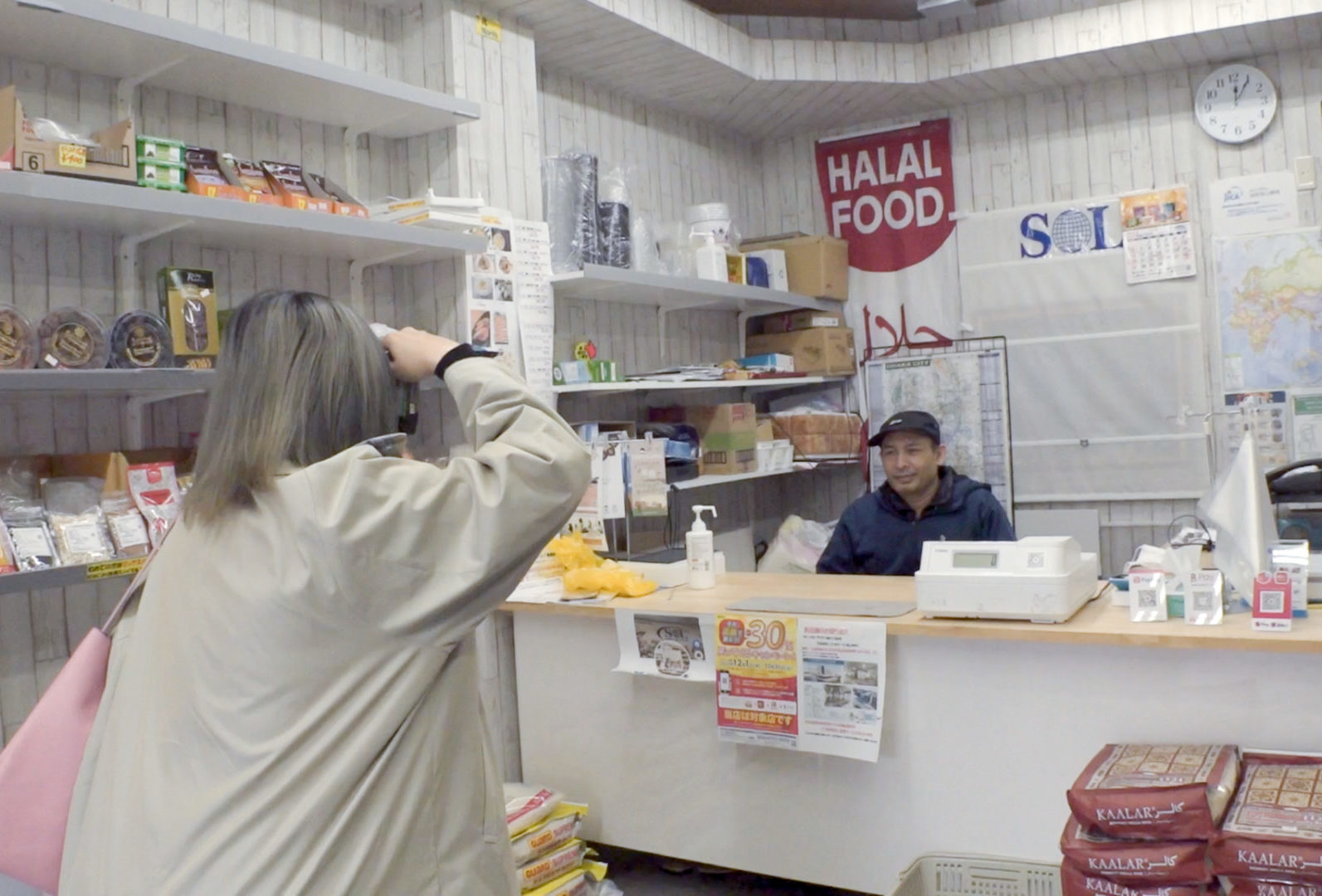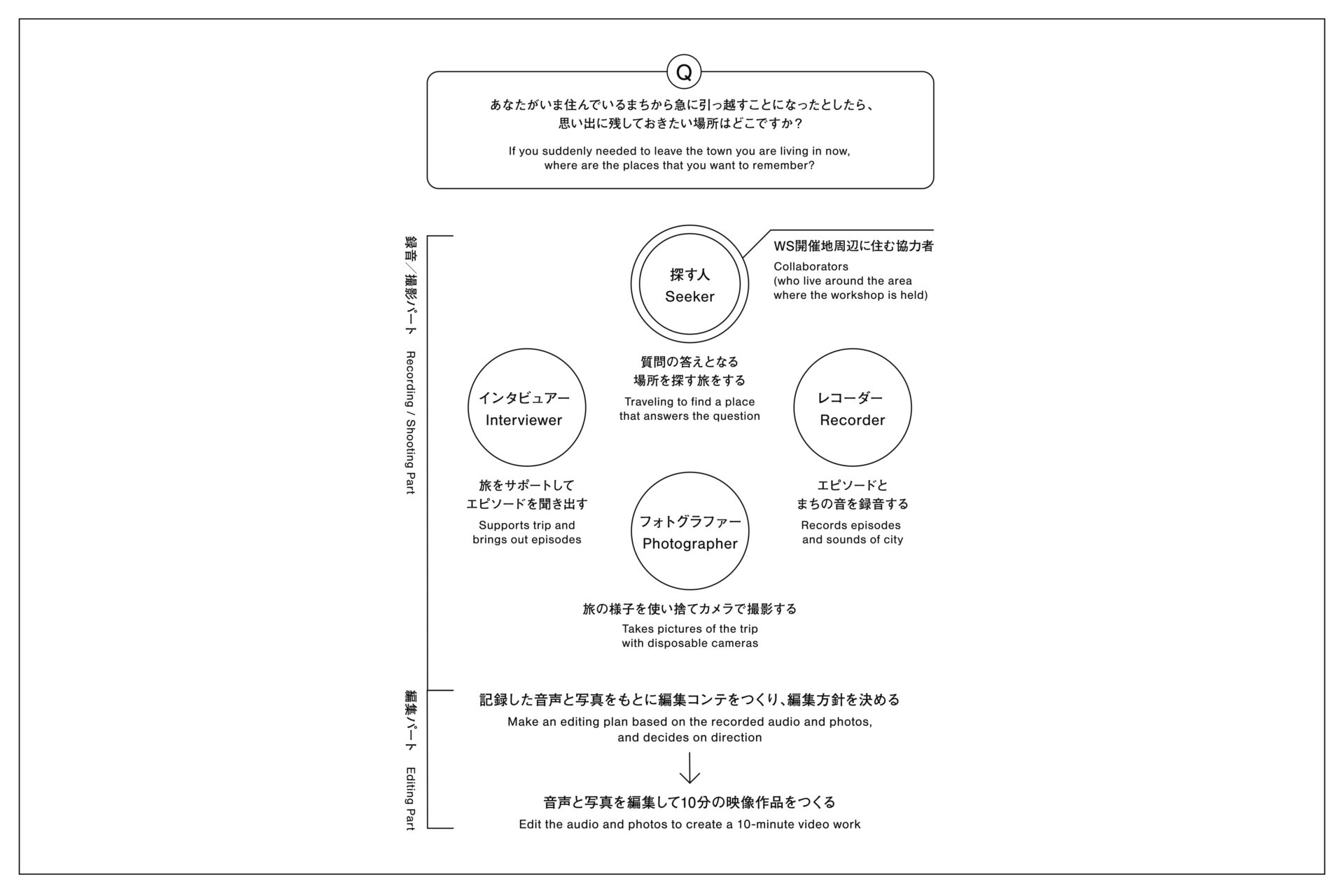
手法3:ムービングムービーMethod 3: Moving Movie
ムービングムービーのルールThe rule of Moving Movie
「シネマポートレイト」で試みたことを、外部の協力者とともに実践する。ワークショップの開催地周辺に住む海外に(も)ルーツをもつ協力者に「あなたがいま住んでいるまちから急に引っ越すことになったとしたら、思い出に残しておきたい場所はどこですか?」という質問を投げかけて、その場所を探す旅を記録する。グループ内では役割をローテーションさせずに固定し、より実際の映像制作の現場に近いプロセスで制作する。
・探す人(協力者):引っ越すことになったと仮定し、思い出に残したい場所を探す
・インタビュアー:「探す⼈」の旅をサポートしながら、ルーツや住んでいるまちについてのエピソードを聞き出す
・レコーダー:エピソードを録音する。加えて、まちの環境音を録音し、演出にいかす
・フォトグラファー:「探す⼈」の旅の様⼦を使い捨てカメラ(27枚)で撮影する
編集パートでは、記録した音声と写真をもとに、編集コンテをグループ内で作成し、おおまかな方針を決める。そのコンテをもとに、編集ソフトを用いて10分の映像作品を完成させる。The workshop that applies what was attempted in “Cinema Portrait” with outside collaborators. The collaborators, who have background overseas, were asked the question, “If you suddenly needed to leave the town you are living in now, where are the places that you want to remember?” and record their trip to find those places. The roles within the group were not rotated but fixed, making the production process more similar to processes in actual filmmaking.
- Seeker (the collaborator): Assuming they were moving out of the city, search for places they want to keep as memory
Interviewer: Supports Seeker on their trip, interviewing them about their background and where they live
- Recorder: Records the episodes of the Seeker, along with environmental sounds of the town to be used in the production
- Photographer: Record the Seeker’s trip with a disposable camera (27 photos)
For the editing portion, the group creates a storyboard as an editing plan based on the recorded audio and photos, and decides on a rough direction. Based on the storyboard, the group completes a 10-minute video work using editing software.

ムービングムービーの作品The works of Moving Movie
「ムービングムービー」における「探す人」は、運営スタッフによる事前リサーチや、他の協力者からの紹介をとおして、ワークショップを開催するエリアに住む人に依頼している。一般公募で集まった参加者の多くは、それまでに開催地との縁がなく、初めてそのエリアに訪れた人も少なくない。そのような参加者たちが、その地で生活を営む協力者とまちを歩くことなるわけだが、「思い出に残したい場所はどこか?」という質問を出発点とすることで、案内する/されるという決まりきった体験ではなく、参加者と協力者とが共有できる新しい体験となることを目指している。
参加者たちは、手持ちマイクとレコーダー、そして使い捨てカメラ(27枚撮り)を用いる。それは、現場で初めて出会う「探す人」と向き合う際に、機材の扱いの負担を減らし、話を聞くこと、旅を記録することに意識を集中させる意図がある。また、インタビュアー/レコーダー/フォトグラファーという役割を固定させることは、参加者それぞれの判断を積み重ねて一つの作品をつくるというプロセスの体験になる。
写真のスライドショーに個人の語りが重なるという構図は「シネマポートレイト」と同じではあるが、「シネマポートレイト」が断片的な印象を与える一方で、「ムービングムービー」では「探す人」一人に注力して記録した素材の厚みが作品に現れる。その厚みは「探す人」の視点やキャラクターをより明確に立ち上がらせるが、それは旅をともにした、つくり手である参加者たちの視点も反映された「探す人」の姿である。The Seekers for “Moving Movie” are people who live in the area where the workshop is to be held, contacted through advance research by the staff and introduced by other people who have cooperated. Many of the participants had no previous connection to the area where the workshop was held, and for many it was the first visit. As these participants walk the city with the collaborators who have lived in the area, they start with the question, “Where is the place you want to leave in your memories?” The goal is to create a new experience that can be shared by both participants and collaborators, rather than a clichéd experience of guiding or being guided.
Participants will use a hand-held microphone, recorder, and disposable camera (27 shots). The intention is to reduce the burden of handling the equipment and to focus their attention on listening and documenting the trip, as they meet the Seeker for the first time in the field. Fixing the roles of Interviewer/Recorder/Photographer also provides an experience of the process of creating a single work of art by accumulating the judgments of each participant.
The structure is similar to that of “Cinema Portrait” in that individual narratives are overlapped with a slideshow of photographs, but while “Cinema Portrait” appears rather fragmented, “Moving Movie” focuses on a single Seeker, and the thick layers of the recorded material appear in the work. That depth makes the perspective and character of the Seeker stand out more clearly, but this shows a figure of the Seeker that also reflects the perspectives of the participants, who are the filmmakers, that shared the trip together.

